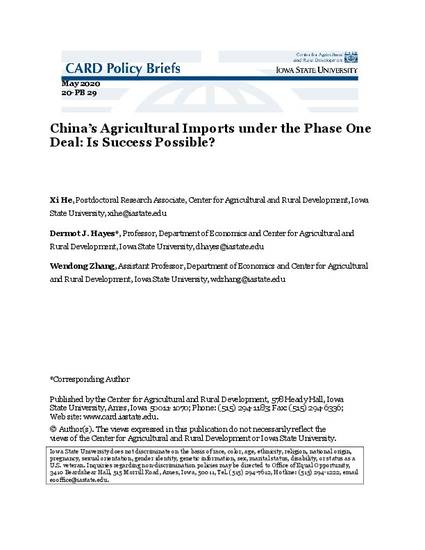
We examine China’s committed agricultural purchases under the phase one trade deal and whether it can fulfill those commitments due to the COVID-19 pandemic. We review China’s actual agricultural imports from the United States and other countries up to the first quarter of 2020 and analyze trade deal obligations China must still meet by the end of 2020. We use prior seasonal patterns and US-China price differentials to predict China’s agricultural imports from the United States in 2020. We examine total agricultural and related products with special focus on corn, soybeans, cotton, sorghum, pork, and beef.
The data show China currently has an enormous market demand for agricultural imports, and, to date, has imported large quantities of pork, cotton, sorghum, and soybeans from the United States. However, China imports an even greater amount of agricultural products from other countries, which, in part, reflects a continued diversification away from US agricultural imports before and during the trade war. We predict China will import $18.60 billion in agricultural products from the United States in 2020, far behind the phase one target of $36.5 billion.
The first quarter of 2020 was a trying time for agricultural trade, especially for China, so there is still room for optimism, and we see several positive signs that China will accelerate its agricultural purchases. First, US-China price differentials of relevant commodities recently increased, providing a market signal for China to increase imports from the United States. Second, there are indications that, beginning in October, China plans to import large quantities of corn, as its domestic supply gap has widened. Third, China has announced its intention to purchase 20 million tons of corn, 10 million tons of soybeans, and one million tons of cotton for its national reserve. Fourth, China is short on animal protein due to the African Swine Fever outbreak, and thus is purchasing an increasing share from the United States. Fifth, China is making good progress meeting the regulatory and structural changes promised as part of the phase one deal, including updating lists of US facilities eligible to export distillers dried grains with solubles and beef and pork products lists. However, US-China trade prospects depend critically on COVID-19’s impact on international logistics and China’s political willingness to allow US imports to return to and exceed pre-trade-war levels. We provide a commodity specific estimate of what China will need to import from the US in the last three quarters if it is to meet the terms of the deal by the end of 2020.
Available at: http://works.bepress.com/dermot_hayes/213/
